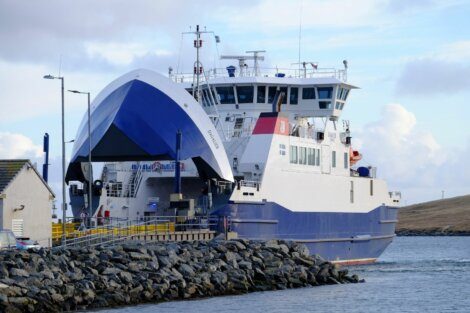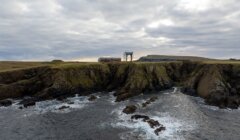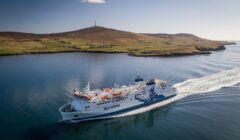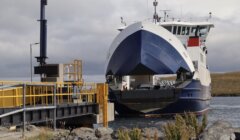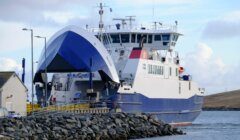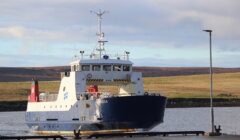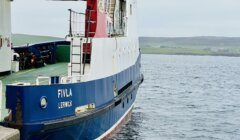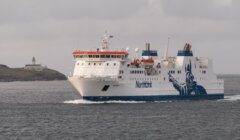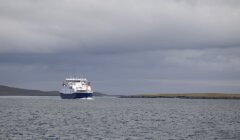Transport / SIC’s ferry maintenance bill reached £5.4m last financial year
IT COST Shetland Islands Council (SIC) nearly £5.4 million in the last financial year to maintain its ferry fleet.
The figure for the current financial year, from the start of April through to the end of July, already stands at £1.24 million.
Campaigners for tunnels in Shetland said the figures, obtained through a freedom of information request, further strengthen the case for fixed links.
Meanwhile Shetland Islands Council’s environment and transport committee chair Moraig Lyall said maintenance costs – currently covered by government funding – will be “considerable” as vessels get older.
“You can clearly see this is a substantial and increasing cost,” she said.
The SIC’s ferries, which link the islands to the Shetland mainland, are ageing fast; the Hendra on the Whalsay service, for example, first entered service in 1982.
The Snolda, which runs to Papa Stour, is around 40 years old – while the newest are Yell’s Dagalien and Daggri, the council’s two largest ferries which entered service in 2004.
The figures show that in 2021/22 around £4.7 million was spent on ferry maintenance, with roughly £5.4 million in the last financial year.
For the 2023/24 financial year through to 31 July, the cost has been around £1.24 million.
The service with the highest maintenance cost over this entire time period was Yell Sound at around £3.7 million.
The cost of maintaining the Whalsay ferries stood at around £2.35 million, Skerries was £1.36 million and Bressay was just over £1 million.
The spend on the Unst ferries was just under £1 million. Fetlar, which is part of the Bluemull Sound service, was listed with a similar spend.
The cost of maintaining the Papa Stour ferry stood at more than £500,000, while Fair Isle was around £375,000.
The costs associated with maintaining the Foula ferry – the only service outsourced to a private company, BK Marine – was just £428.
Become a member of Shetland News
Many of the services have two vessels, such as Yell and Whalsay, while Bressay and Skerries are among the routes with just one.
The SIC said vessel maintenance costs includes a wide range of areas, from repairs, dry dock, equipment and lubricants to cleaning, plant fuel and licence fees.
Councillor Lyall said the costs are fully covered by the grants the SIC receives annually from the Scottish Government.
She said this is “one of the reasons I see tunnels not only as a good thing for our island community, but also for the central government whose commitment to fund our ferry network would reduce as the routes are replaced by fixed links”.
“Their support in our aspirations for these developments would also serve them well in the longer term,” Lyall added.
The council’s position is that it is in favour of fixed links to as replacements for the busiest ferry routes – Yell Sound, Bluemull Sound, Whalsay and Bressay.
But questions have always remained over who would foot the prospective bill.
In the meantime talks continue between the council and the Scottish Government over its currently unfunded ferry replacement programme, and there is a hope from the SIC that fixed links form part of the discussions.
Grassroots tunnel actions groups organised by communities in Yell and Unst, however, recently teamed up to fundraise itself for initial geophysical surveys for possible tunnels to the two islands.
After around three weeks an online fundraising page has attracted more than £5,600.
Unst Tunnel Action Group chair Alec Priest said the maintenance figures “reinforces the need for a sustainable and affordable transport model to the isles”.
“The increasing annual cost of maintaining the ferries safe operational level is a vulnerability to the isles who depend on them,” he said.
“This maintenance costs are only a small part of the overall ferry fleet operating costs which are currently approx. £24 million this year.
“The fares for the ferries can only cover about 10 per cent of the annual operating budget and cannot recover any of the capital costs of a ferry service.
“Tunnels in Faroe and Norway, with similar fares to our ferries can recover 100 per cent of the capital cost and 100 per cent of the annual operational and maintenance costs over a couple of decades.”
Priest said in his view this [tunnels] would be a more effective use of taxpayers’ money.
“As someone who has an interest in how my taxes are being spent, I am frustrated to see our taxes not being spent as efficiently on transport as our neighbouring countries, especially since our more expensive option generates significantly more CO2, is not financially sustainable and does not allow unrestricted travel to and from the isles,” he said.
The two groups said having tunnels to Yell, and between the island and Unst, would “foster inclusivity and drive sustainable development”.
In the last few years, after plenty of political lobbying, the Scottish Government has provided ‘fair ferry funding’ to the council to cover the deficit in running services.
Earlier this year it was also confirmed the SIC was successful in its bid for UK Government Levelling Up funding for a new Fair Isle ferry, plus associated harbour upgrades.
Become a member of Shetland News
Shetland News is asking its many readers to consider paying for membership to get additional features and services: -
- Remove non-local ads;
- Bookmark posts to read later;
- Exclusive curated weekly newsletter;
- Hide membership messages;
- Comments open for discussion.
If you appreciate what we do and feel strongly about impartial local journalism, then please become a member of Shetland News by either making a single payment, or setting up a monthly, quarterly or yearly subscription.






